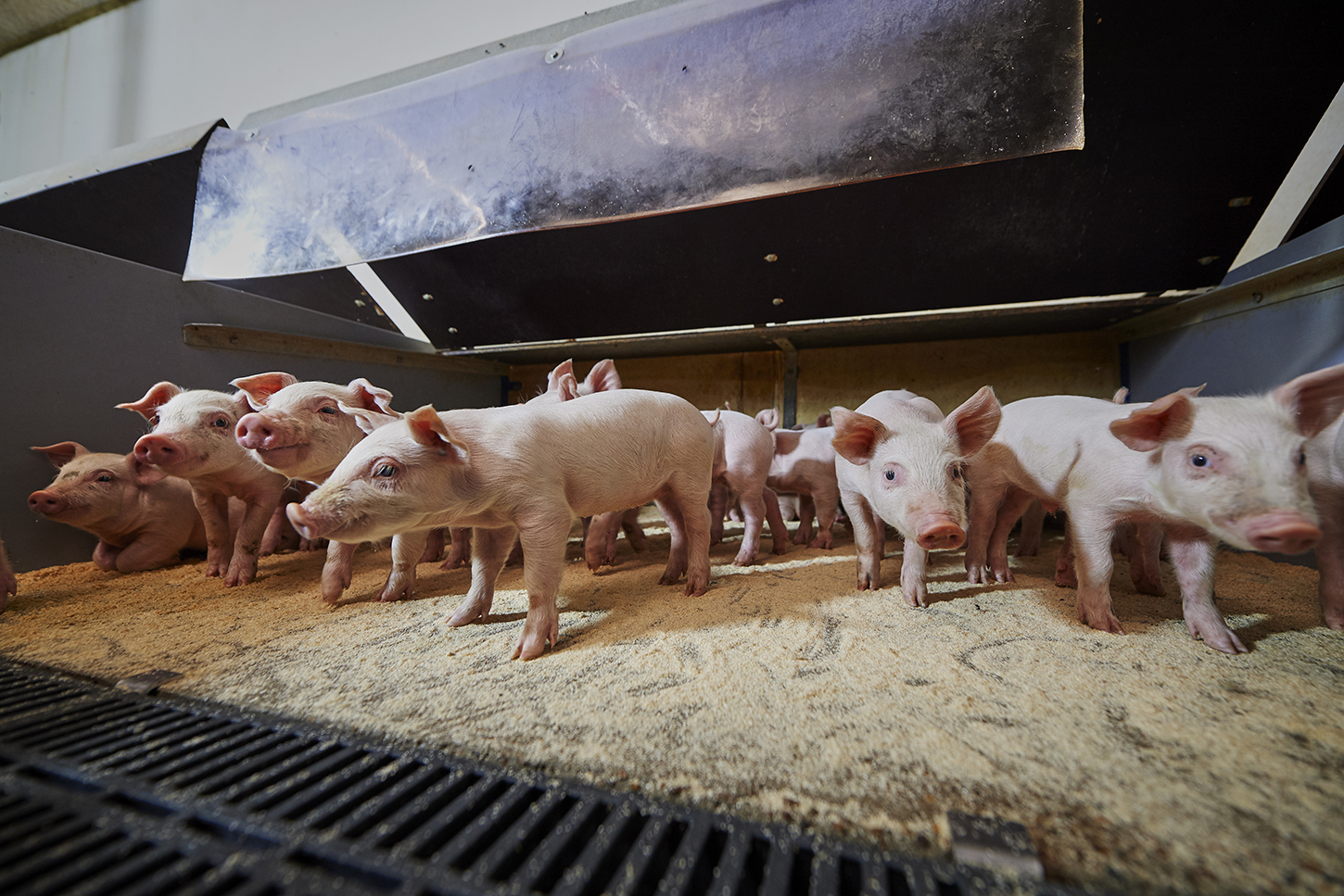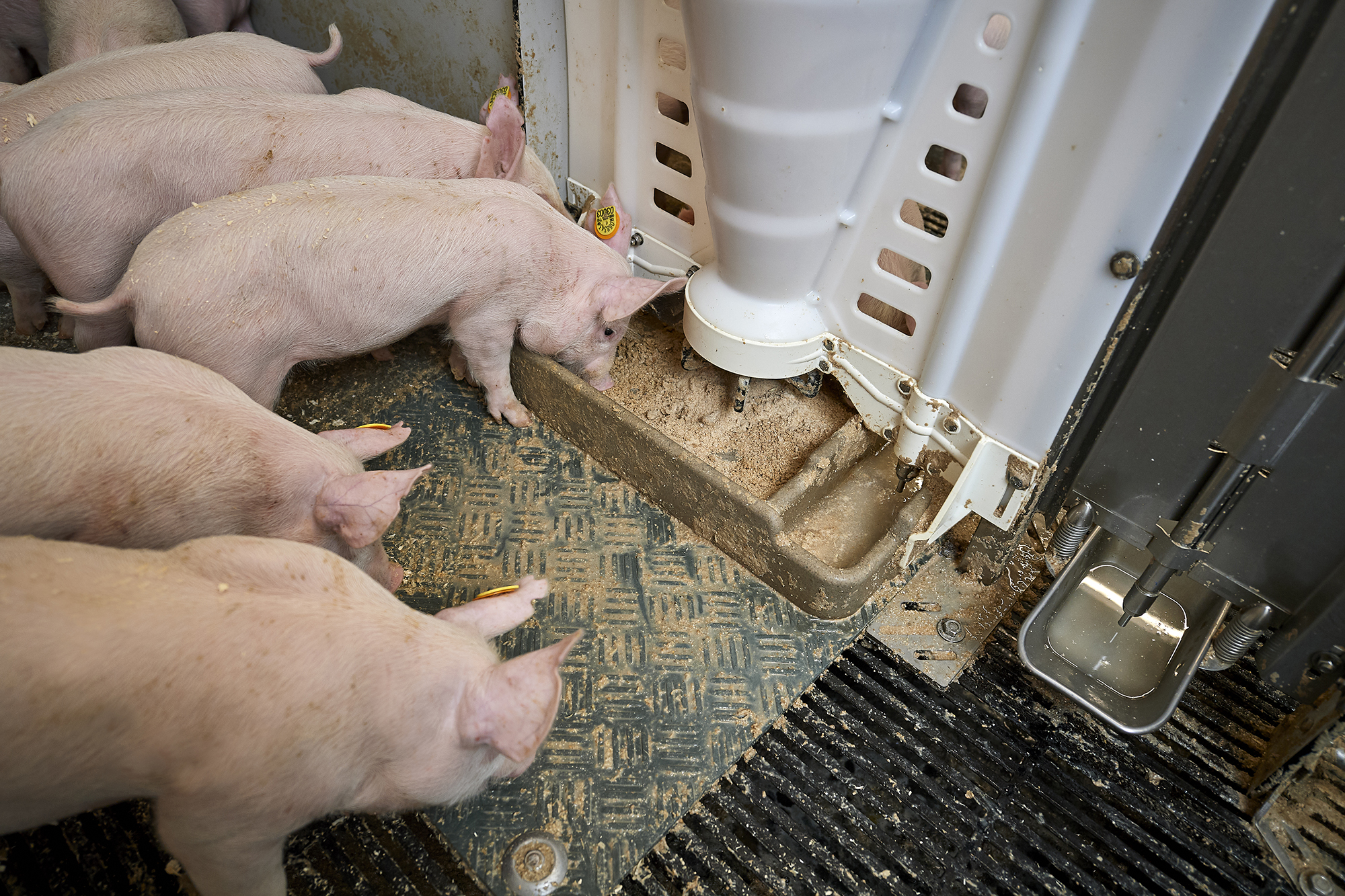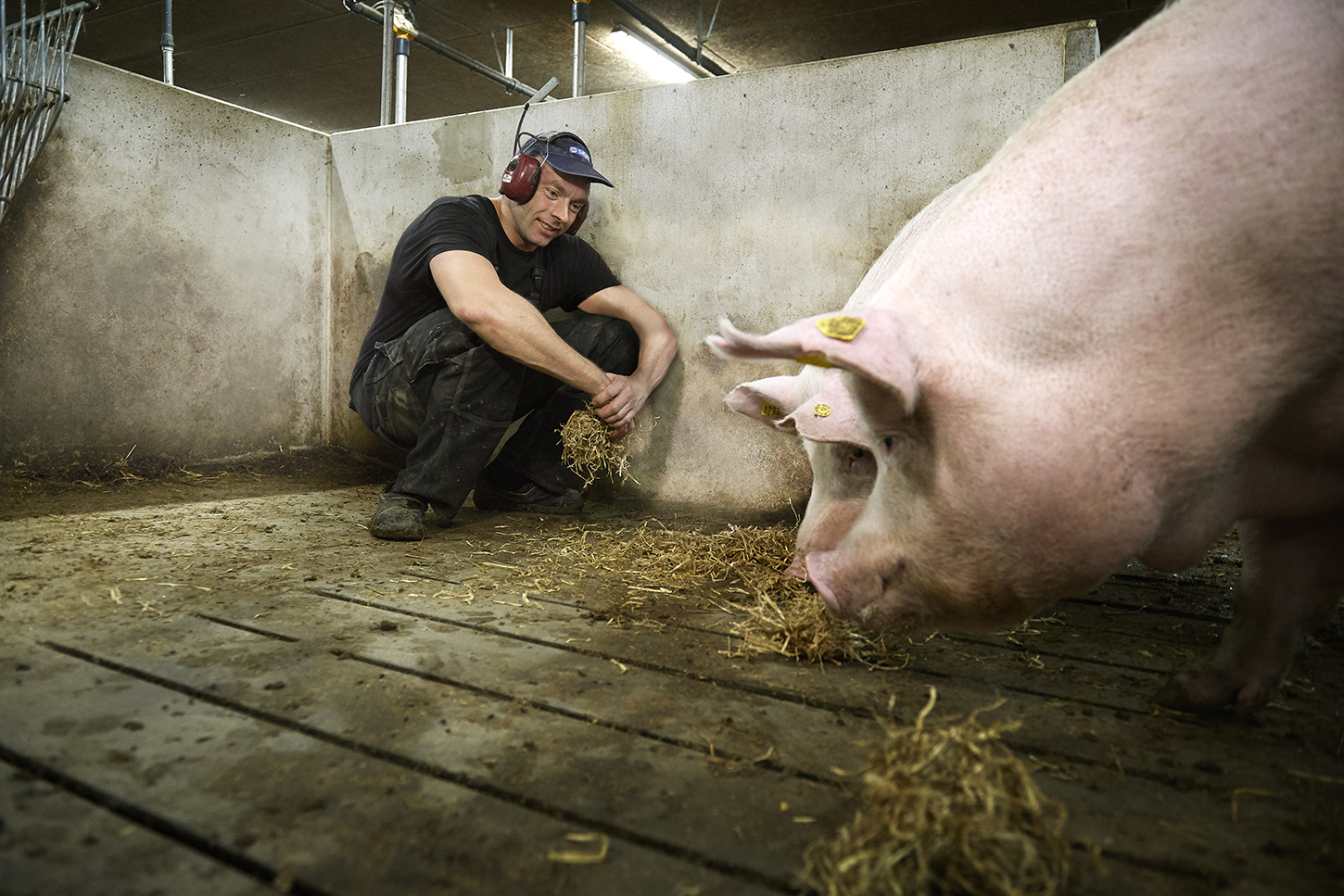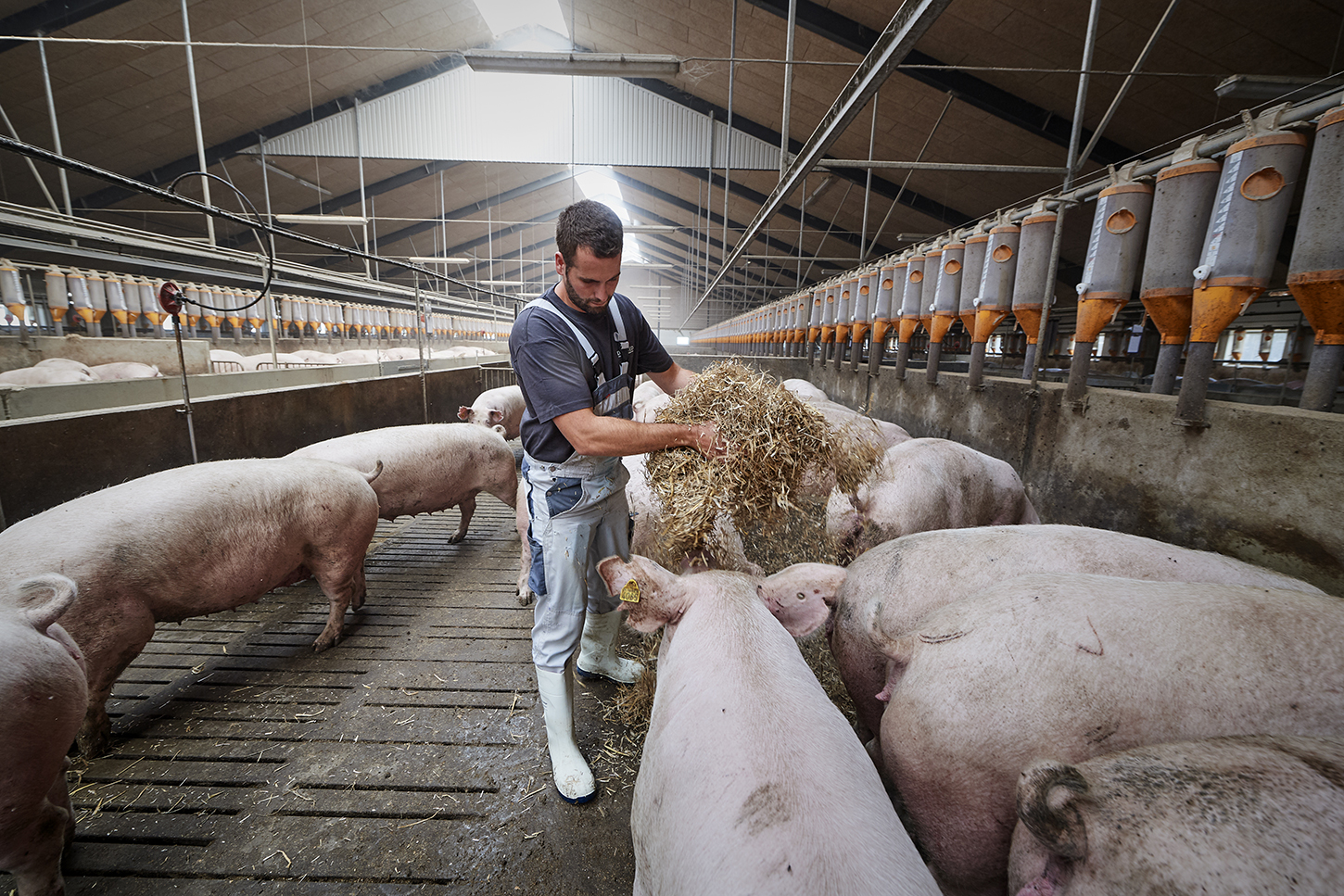Feeding gilts
Feeding that ensures optimal breeding animals
Conditions in the growth period should be adjusted according to the desired design of the breeding animals. The table shown below outlines the goal for the optimal DanBred gilt at the time of first insemination (except for gilts in nucleus herds):
| Goals | Recommendations |
|---|---|
| Weight | 150-165 kg |
| Backfat measurements, mm | 13-15 mm |
| Avg. daily gain, from 30 kg to first mating | 900 g/day |
| Age at first mating, days | 210-250 days |
*For boars, the same criteria should apply in terms of the recommendations on average daily gain.
|
|
|
Feed, and water supply in the rearing unit
The design of gilts at the time of first insemination depends to a high extent on feeding principles and the quality of the feed. First and foremost it should be underlined that breeding animals are to be fed as breeding animals, and not finishers.
 |
 |
Nutrition and feeding are the foundation of animal growth, composition, and general health. Feed composition must ensure the actual physical needs of animals, at all times. The general focus when feeding breeding animals is leg and bone strength as well as controlled growth to ensure improved longevity and quality of the animals. It is important to maintain an optimal growth curve throughout the period, ensuring high-quality animals.
| Age, days | Age, weeks | Weight, kg | Avg. daily gain (g/day) |
|---|---|---|---|
| 28 | 4 | 7 | 250 |
| 56 | 8 | 18 | 430 |
| 70 | 10 | 27 | 430 |
| 84 | 12 | 35 | 500 |
| 112 | 16 | 60 | 500 |
| 140 | 20 | 88 | 500 |
| 168 | 24 | 116 | 570 |
| 196 | 28 | 140 | 615 |
| 224 | 32 | 163 | 640 |
| 84-245 | 10-32 | – | 900 |
Feed and water supply – until 30 kg
Focused feeding should begin in the weaning unit immediately after weaning, although the differences between breeding animals and regular weaners are quite small. Common for both animal types are the first 5-7 days after weaning, where the heightened focus is needed to minimise post-weaning diarrhoea, and ensure that the animals get off to the best start possible.
|
|
|
The composition of the feed must furthermore be based on the optimal nutrient profile based on quality animals, and of course efficiency. The physiology of the animal should always be taken into consideration, e.g. by using simple feed mixes with high-quality feedstuffs, to minimise post-weaning diarrhoea and ensure high digestibility.
| Diet | Starter compound | Finisher compound |
|---|---|---|
| Age interval
(weight) |
4–6 weeks
(6–15 kg) |
6–10 weeks
(15–30 kg) |
| Energy density per kg feed | 14.0 MJ ME/
10.3 MJ NE/ 1.16 FUgp |
13.6 MJ ME/
10.0 MJ NE/ 1.12 FUgp |
| Std. digestible lysine, g/kg | 12.8 | 12.9 |
| Minimum St.dig.crude protein, g/kg | 162 | 160 |
| Maximum St.dig.crude protein, max g/kg | 172 | 169 |
| Digestible phosphorus, g/kg | 3.7 | 3.7 |
| Calcium, 60-100%, phytase, g/kg | 8.7 | 9.0 |
It is recommended to use a liquid starter mix, for the first 5-7 days after weaning:
- Mix together 5 parts water, 1 part milk, and 2 parts feed.
- Allow a maximum of 1 litre mixture for every 10 pigs.
- The pigs must empty the trough in 20 to 30 minutes.
- Feed the liquid starter mix, to the pigs at least four times per day, the more feedings the better.
|
|
|
When using a liquid starter mix, it is essential to maintain a high level of hygiene, to minimise the growth of harmful mould and bacteria in the feed and troughs. It is recommended to clean the troughs with water after each feeding, and it can also be advantageous to leave a small amount of water in the trough, to encourage water intake.
|
|
|
When the first week has passed, the pigs should mainly be fed with dry feed or regular wet feed. For the first 12 days, the pigs should be fed restrictively, after which they can be fed ad libitum.
The water supply in this period is, as previously stated, also essential to keep the pigs active and healthy. It is recommended to always have access to clean drinking water, and a minimum of 2 drinkers per pen. The drinkers should be placed as close to the feed supply as possible, ensuring optimal usage and an increased feed intake – the drinkers should provide a minimum of 0.5-1.0 litres per minute.
|
|
|
The weaning unit lays out the foundation for the remaining growth period, and it is essential that they get off to a good start in order to ensure optimal growth and healthy high-quality breeding animals.
Feed and water supply – from 30 kg
From here on out it is important to control growth in the animals. By maintaining an average daily gain of 900 g/day from 30 kg and up to 150 kg optimal fat deposits are ensured together with improved heat and reproductive performance. The controlled average daily gain will furthermore improve conformation and overall conformation, as the bones are not overloaded and pressured to the same extent – and at the same time, bones are strengthened by optimal mineralisation.
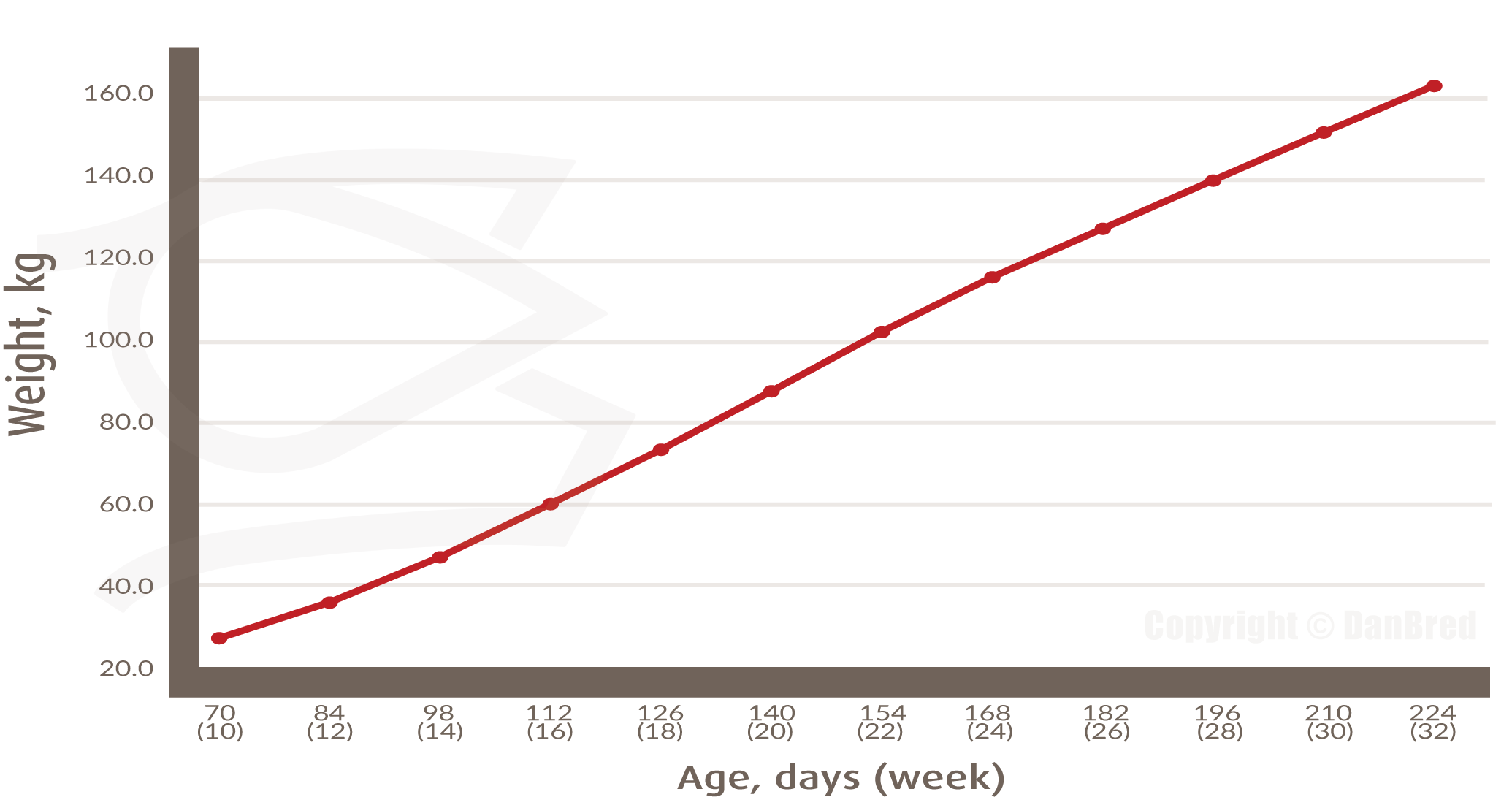
Phase feeding of DanBred gilts will secure good longevity and lifetime productivity. Feeding DanBred gilts according to one of the following feeding scenarios will assure optimised performance and fitness of the gilts.
| Scenario 1 | Gilts 30-60 kg | Gilts 60-110 kg | Gilts >110 kg |
|---|---|---|---|
| Scenario 2 | Gilts 30-85 kg | Gilts 85-110 kg | Gilts >110 kg |
|
|
|
The table below shows the recommended feed composition when restricted feeding is used from 30 kg and up.
| Restricted feeding | 30-60(85) kg | 60-110 kg | 85-110 kg | > 110 kg |
|---|---|---|---|---|
| Energy density per kg feed | 13.0 MJ ME/kg 9.8 MJ NE/kg 1.07 FUgp/kg |
12.8 MJ ME/kg 9.7 MJ NE/kg 1.05 FUgp/kg |
12.7 MJ ME/kg 9.6 MJ NE/kg 1.04 FUgp/kg |
12.5 MJ ME/kg 9.4 MJ NE/kg 1.02 FUgp/kg |
| SID lysine per kg feed (g) | 8.2 | 6.3 | 5.2 | 4.1 |
| Total lysine per kg feed (g) | 9.4 | 7.2 | 6.0 | 4.7 |
| Min. SID crude protein per kg (g) | 126 | 105 | 94 | 82 |
| Phosphorous per kg (g) | 5.6 | 4.4 | 4.4 | 3.9 |
| Digestible phosphorus per kg (g) | 3.2 | 2.4 | 2.4 | 2.0 |
| Calcium per kg (g) | 8.6 | 7.4 | 7.3 | 7.3 |
² Based on the usage of 100% phytase

**Does not apply to animals in the performance test in nucleus herds.
If you want to further enhance fat deposition, it is recommended to use a top dressing (on top of the regular feed), consisting of 2 % fat, 50 % barley, 50 % wheat, vitamins and minerals. The general strategy for feeding should be based on quality feedstuff and an overall goal of healthy and productive development in the breeding animals.
|
|
|
Feed stuffs
The breeding animals determine the future productivity in the herd and with the customers. As feeding is an important factor throughout the growth period, the choice of feedstuff must also be taken into consideration in order to achieve the desired quality of the breeding animals.
Potentially expensive feedstuffs can often be replaced by cheaper alternatives such as residue products from various productions (e.g. potato pulp or whey). From an economical point of view, this can seem like a good solution that often is without negative effects on productivity. But in all cases, you should be aware that a cheaper alternative can be linked with different risk factors and unforeseen collateral. So even though it is economic at this point, this might not be the case in the long run – as some of these residue products are lacking in testing, and might cause unforeseen damages to productivity and compromise animal quality. If residue products are chosen, it is important to have nutritional value in mind as well as the risk of diverse quality differences in deliveries.
|
|
|
When feeding breeding animals- especially gilts- there should be an increased focus on endocrine disruptors and factors with a possible negative influence on reproduction. Focus on the nutritional content and test for fluctuations in deliveries so that you are always able to meet the actual physical need of the animals.
Gastric health
Gastric health is essential to productivity ad longevity in highly prolific breeding animals, and this should begin already in the early stages of development. Focusing on feedstuffs, quality of feed and feed composition will assist with this- most importantly ensuring the particle size is correct to prevent the development of gastric ulcers.
Feed mixes with a high fibre content
Feed mixes rich in fibre have shown to have a positive effect on gastric health, and also being an important parameter in preventing gastric ulcers. In many herds fibres are in addition to gastric health, showing a positive effect on the production of uniform breeding animals – which is one of the key goals in the production of breeding animals. Fibres should always be added to the feed mixes, and choosing feedstuffs should always be considered – to ensure general health and uniform quality animals.
When adding fibres, it is important to not only consider the amount to add but also the fibre source. Choosing between different fibre sources of course depends on availability, but also the complexity of its composition which affects the digestibility. There are different choices which can all be good for breeding animals. The choice of fibre source is important for the subsequent amount added to the feed mixes – which furthermore depends on the feed strategy.
| Fibre source | Guidelines for fibre percentages | |
|---|---|---|
| Ad libitum feeding | Restrictive feeding | |
| Sugar beet pellets | 5-10 | 0-10 |
| Alfalfa pellets / Green meal | 0-5 | 0-5 |
| Wheat bran | 0-20 | 0-20 |
| Oats | 0-50 | 0-50 |
| Oat husk meal | 0-5 | 0-5 |
| Rye | 0-40 | 0-40 |
With a high fibre content in the feed mixes, the feed intake is reduced and the time spent eating increases – both factors in controlled daily gain. Fibres can ensure a more uniform feed intake in the pens, and ensure uniformity in the animals.
|
|
|
The fibres promote satiation in the animals, ensuring general welfare, as this will mean calmer animals with fewer behavioural issues in general. Furthermore, this will ensure gastric health as well, as the fibres thicken the content of the stomach – minimising the risk of gastric acid coming into contact with the lining of the stomach, thus reducing gastric ulcers.
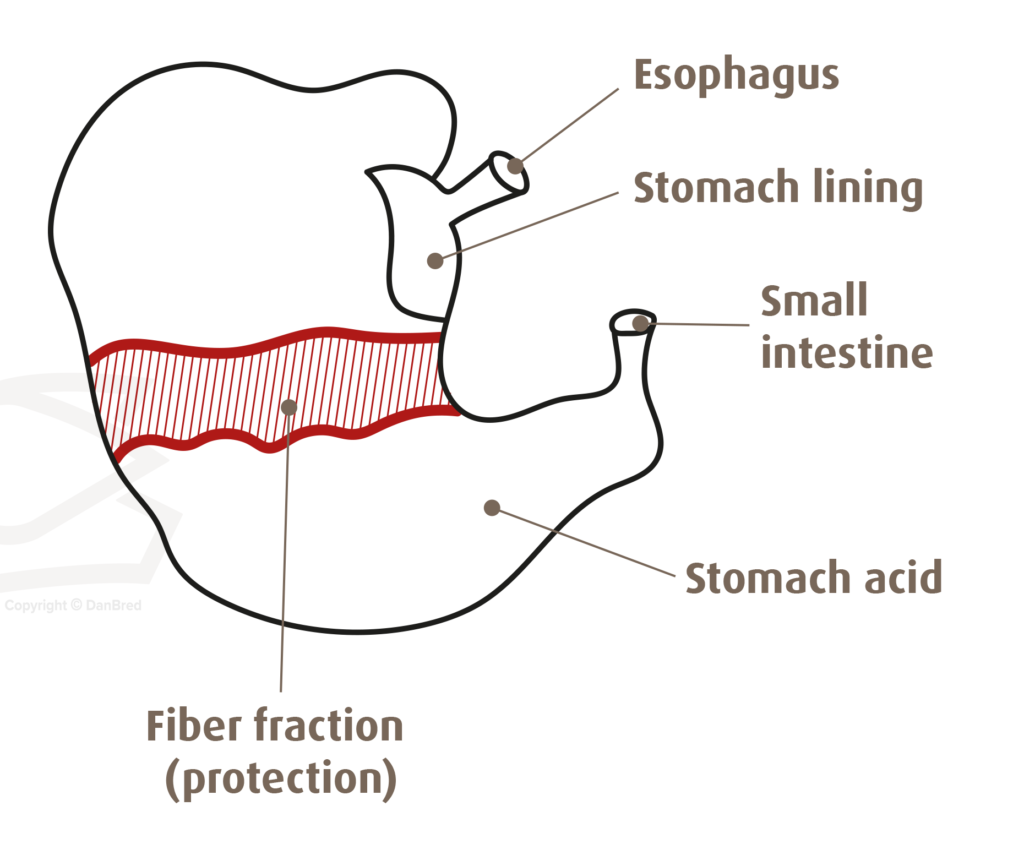
Grinding of the feed
Fibre-rich feed mixes cannot stand alone, and cannot replace the need for focus on feed types and grinding levels of the feed. The correct grinding of feed is also important in ensuring gastric health and should be monitored on a regular basis – for example by using a Bygholm sieve and a sieve profile or wet sieving of pellets or expandate. If the amount of particles smaller than 1 mm is increased further than the recommended level, the risk for gastric ulcers increases significantly.
Problems with gastric ulcers can appear within just a few days if the grinding of the feed is drastically increased. Subsequently scarring will be formed, causing permanent damage to the animals. If a breeding animal has suffered from a severe gastric ulcer, scar tissue is formed, causing the oesophagus to be more narrow (scarring at level 9-10, SEGES scale), which has proven to reduce the following feed intake. This is why ongoing monitoring of the feed grinding should be managed, and why the recommended composition of particles should be followed.
| < 1 mm | 1-2 mm | 2-3 mm | |
|---|---|---|---|
| Particle size | 50 % | 35 % | 15 % |
*Degree of grinding should be adjusted at herd level, based on results from gastric necropsies.
The number of daily feedings should be distributed throughout the day, and include a minimum of 3-4 feedings per day. In particular, when using the pelleted feed, has proven to minimise the risk for gastric ulcers, compared to ad libitum feeding. When using meal feed, it is also recommended to use restricted feeding, with 3-4 feedings per day – but the differences are not as profound as with pelleted feed.
It is recommended to feed breeding animals with coarsely ground meal feed or coarse expandat e feed. If the pelleted feed is chosen, it is recommended to add 10-20 % rolled, non-toasted barley (grain around pellets). A coarser grinding of the grain within the pellets can contribute to some structure, but the pelleting process grinds the feed in such a way that it is not recommended for breeding animals.

In addition to the choice of individual feed types, feedstuffs and grinding – vitamins and minerals are also significant during the growth period. Calcium and phosphor are essential elements in growing animals, as they are vital in optimal mineral deposits in bone formation and hence the conformation of the animals.
Vitamins and minerals
Both vitamins and minerals are essential elements in animal metabolism and contribute to optimal productivity and growth. All vitamins and minerals are important in the period of growth, however, some elements are more important than others – and some are even more important in breeding animals.
Minerals
Calcium (Ca) and phosphor (P) are the only minerals that stand out with breeding animals compared to other animal groups. Both minerals play an essential role in bone mineralisation, which is important for future longevity – meaning there is a higher need in the feed for breeding animals. Bone mineralisation is the foundation for bone strength, and overall conformation since bone strength affects the animals’ ability to carry its own weight.
|
|
|
Calcium and phosphor are intertwined in absorption and must be looked upon in relation to one another rather than individually. If Ca and P are not added in adequate amounts during growth, bone strength will be diminished and the growth of the animal will be constrained. However, overdosing on these minerals will also impair mineralisation in the bones, as this will constrain movement and the animal’s future ability to mobilise Ca and P from the bones.
Typically the Ca/P ratio is 2:1 which will enable optimal bone deposition. However, you should always be aware of updated recommendations and that different levels of phytase added will further increase the availability of Ca and P in the feed. The interactions of minerals should furthermore be seen in relation to the vitamins added to the feed.
Vitamins
The vitamins that play an essential role in animal growth and breeding animals are especially vitamins affecting reproduction, bone strength and claw health. Not only the vitamins themselves but also interactions between vitamins and minerals must be taken into account to achieve the most optimal result.
For example, vitamin D is absorbed in combination with Ca and P, hence playing an important role in both bone mineralisation and the carrying capacity of the animal. A vitamin D deficiency will result in deformed and soft bone structures, causing lameness and weaker conformation of the animals. Similarly, several vitamins play a significant role in the growth period of breeding animals, and hence future quality.
| Vitamin | Essential to |
|---|---|
| Vitamin H (Biotin) |
|
| Vitamin A |
|
| Vitamin E |
|
| Vitamin K |
|
However, adding vitamins to the feed should take the natural occurrence in each feedstuff into consideration. And also consider the body’s own ability to create some vitamins. The addition of vitamins should always follow the updated recommendations.
| 30-110 kg | > 110 kg | |
|---|---|---|
| Vitamin A, 1000 IU/kg | 10 | 10 |
| Vitamin D3, 1000 IU/kg.* | 1.0 | 1.0 |
| Vitamin E, mg/kg | 80 | 80 |
| Vitamin K3, mg/kg | 2,1 | 2,1 |
| Biotin, mg/kg | 0.4 | 0.4 |
*Vitamin D should be added based on the actual level of D3 or D3 content e.g., Hy-D – 1 mg Hy-D equals 40 i.e. vitamin D3.



